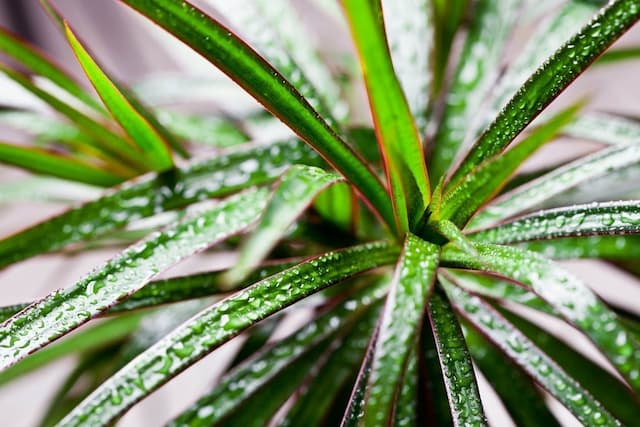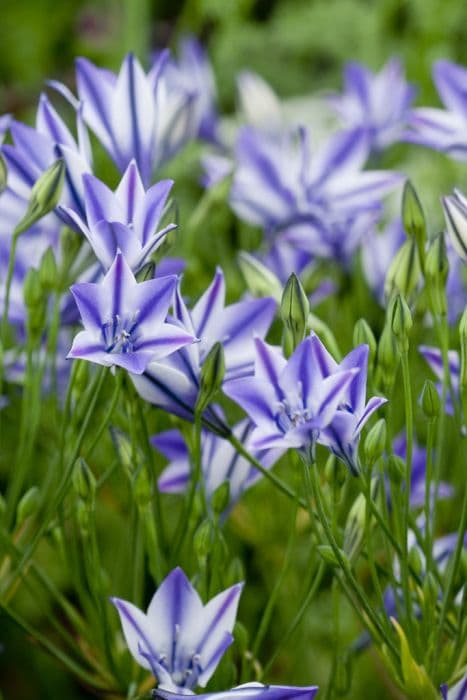Lily of the Valley Convallaria majalis

ABOUT
Commonly known as Lily of the Valley, this plant is a perennial with a lush, green appearance. Its leaves are broad, elongated, and have a smooth texture, forming a basal rosette at the base. The delicate, bell-shaped white flowers are small and fragrant, hanging from a single, slender stalk. Each flower has a slight curvature, giving it a dainty, nodding appearance. The plant also bears small, orange-red berries after flowering, which stand out against the foliage. The overall impression is one of an elegant and graceful plant, often associated with its sweet scent and classic beauty.
About this plant
 Names
NamesFamily
Asparagaceae.
Synonyms
Lily Of The Valley, May Bells, Our Lady's Tears, Mary's Tears, Convallaria, Jacob's Ladder, Ladder-To-Heaven, Male Lily, May Lily, Lily Constancy, Mugget, Liry Of The Valley.
Common names
Convallaria bracteata, Convallaria latifolia, Convallaria majalis var. keiskei, Convallaria majalis var. montana, Convallaria majalis var. transcaucasica, Convallaria majuscula, Convallaria parviflora, Convallaria polygonatum, Convallaria rotensis, Convallaria transcaucasica, Convallium majale, Lilium convallium.
 Characteristics
CharacteristicsLife cycle
Perennials
Foliage type
Deciduous
Color of leaves
Green
Flower color
White
Height
6-12 inches (15-30 cm)
Spread
9-12 inches (23-30 cm)
Plant type
Herb
Hardiness zones
2-7
Native area
Northern Hemisphere
Benefits
 General Benefits
General Benefits- Aesthetic Appeal: The Lily of the Valley features delicate, bell-shaped flowers and lush green foliage, contributing to its popularity in gardens and as a cut flower.
- Fragrance: With its highly fragrant blooms, Lily of the Valley often finds use in perfumes and scented products.
- Ground Cover: As a spreading perennial, it is effective in covering ground in shaded garden areas, which can help reduce weed growth.
- Hardiness: This plant is known to be hardy and can survive in cooler climates with minimal care.
- Shade Tolerance: The Lily of the Valley thrives in shaded environments, making it suitable for planting under trees or in parts of the garden that receive little sunlight.
- Bee Friendly: The flowers attract bees, which are important pollinators for many other plants in the garden.
 Medical Properties
Medical Properties- Cardiotonic: Convallaria majalis contains cardiac glycosides which have a strengthening effect on the heart muscle.
- Diuretic: The plant has properties that promote the increased production of urine, aiding in the elimination of fluid from the body.
- Sedative: It has been used historically for its calming effects on the nervous system.
 Air-purifying Qualities
Air-purifying QualitiesThis plant is not specifically known for air purifying qualities.
 Other Uses
Other Uses- Lily of the valley is traditionally used as a bouquet flower in weddings, especially in royal weddings, due to its delicate appearance and pleasant fragrance.
- The plant can be used in perfumery, as it has a strong, sweet scent that is highly valued in the making of perfumes and scented oils.
- It is occasionally used for culinary purposes, particularly in the making of syrups and sweet desserts, although one must be very careful due to the plant’s toxic nature.
- In the language of flowers, also known as floriography, lily of the valley represents humility and renewal, and is often included in bouquets to convey these meanings.
- It’s utilized for crafting natural dyes, where parts of the plant can be used to produce green colors when dyeing fabrics or artworks.
- People sometimes use dried lily of the valley flowers in potpourris to maintain a pleasant scent in homes and small spaces.
- Lily of the valley is featured in literature and music, famously in the Christian hymn "The Lily Of The Valley," reflecting its cultural and symbolic significance.
- In some cultures, the blooming of lily of the valley is a herald of spring, and the plant is used in festive decorations during springtime celebrations.
- As a garden plant, lily of the valley is used to fill-in difficult shady areas where other plants might not grow as well, providing ground cover and reducing soil erosion.
- The plant has found its way into commerce, with its motifs prevalent in decorative arts and jewelry, symbolizing purity and simplicity.
Interesting Facts
 Feng Shui
Feng ShuiThe Lily of the Valley is not used in Feng Shui practice.
 Zodiac Sign Compitability
Zodiac Sign CompitabilityThe Lily of the Valley is not used in astrology practice.
 Plant Symbolism
Plant Symbolism- Return of Happiness: With its pleasant fragrance and the emergence in spring, Convallaria majalis, commonly known as Lily of the Valley, is often seen as a symbol of happiness and the return of joy.
- Humility: Its small, delicate blooms that hang unassumingly from the stem serve as a representation of humility and modesty.
- Sweetness: The sweet scent of the flowers can symbolize the sweetness of character and a pure heart.
- Purity: The pure white of the Lily of the Valley flowers is commonly associated with purity and is often used in religious ceremonies and weddings for this reason.
- Motherhood: The plant's reproduction through spreading rhizomes has been interpreted as a symbol of fertility and motherhood.
- Renewal: Blooming in the early spring, the Lily of the Valley signifies renewal, new beginnings, and the rebirth associated with this season.
- Good Luck: In some cultures, the Lily of the Valley is considered a harbinger of good luck and is used in celebrations, such as May Day in France, where it is tradition to give the flowers to loved ones.
 Water
WaterLily of the Valley, or Convallaria majalis, prefers moist, well-drained soil, so it's important to maintain consistent moisture without waterlogging the plant. It should be watered when the top inch of soil feels dry to the touch. Typically, this means watering once or twice a week, providing about 1 inch of water each time, which is roughly 0.6 gallons per square yard of soil. During the active growing season in spring and early summer, keep a closer eye on soil moisture, as the plant may need more frequent watering. However, reduce watering after the plant has finished blooming and during the winter months, when it's dormant.
 Light
LightLily of the Valley thrives in partial to full shade, making it ideal for areas under trees or on the north side of buildings where it can be protected from the harsh midday sun. However, it can tolerate some morning sunlight which can encourage more prolific flowering. Dappled sunlight mimicking a forest understory is the perfect condition for this delicate-looking plant.
 Temperature
TemperatureLily of the Valley is a hardy plant, able to withstand temperatures as low as -40°F and as high as 85°F. However, the ideal temperature range for this plant is between 60°F to 75°F. It doesn't tolerate extreme heat well, so in regions with hot summers, it's particularly important to ensure the plant has adequate shade and moisture.
 Pruning
PruningPruning Lily of the Valley generally involves removing spent flower stalks after blooming and cutting back the foliage when it begins to yellow in the fall. This helps to encourage healthy growth for the next season. Little pruning is required throughout the year, but tidiness can be maintained by removing any dead or damaged leaves as needed.
 Cleaning
CleaningAs needed
 Soil
SoilLily of the Valley prefers well-drained soil rich in organic matter with a pH of 5.5 to 7. A mix of loam, leaf mold or peat, and sand is ideal for this plant.
 Repotting
RepottingLily of the Valley typically does not require frequent repotting and can often be left undisturbed for several years. However, if necessary, repot in the spring.
 Humidity & Misting
Humidity & MistingLily of the Valley thrives in average humidity conditions, with levels around 40-60% being optimal for this woodland plant.
 Suitable locations
Suitable locationsIndoor
Keep in cool, partial shade with moist soil.
Outdoor
Plant in partial shade, moist fertile soil, divide every 3-4 years.
Hardiness zone
3-9 USDA
 Life cycle
Life cycleConvallaria majalis, commonly known as Lily of the Valley, begins its life cycle in spring when its rhizomes send up shoots that unfurl into large elliptical leaves and stems bearing fragrant bell-shaped flowers. After pollination, typically by bees, the flowers develop into small red berries that persist through summer and contain seeds. In autumn, the plant's foliage dies back and the plant enters dormancy for the winter, conserving energy in its underground rhizome. During winter dormancy, the rhizome may spread to form larger colonies of plants. In the subsequent spring, the cycle restarts with new shoots emerging from the rhizome. Over time, Lily of the Valley can spread to form extensive ground cover through both rhizome growth and seed dispersal.
 Propogation
PropogationPropogation time
Spring to early summer
The most popular method of propagation for Convallaria majalis, commonly known as Lily of the Valley, is through division. The best time to divide and propagate Lily of the Valley is in the fall after the foliage has died back or in early spring before new growth begins. Gardeners should carefully dig up the plant clumps, ensuring to lift the underground rhizomes while minimizing damage. These rhizomes, which are horizontal underground stems, can be gently separated into smaller pieces, each with at least one growth point or "pip." These segments can then be replanted at a depth of about 1 to 1.5 inches (2.5 to 3.8 centimeters) in rich, well-drained soil and spaced approximately 6 to 12 inches (15 to 30 centimeters) apart to allow for spread. Water the newly planted rhizomes thoroughly to establish them. Given time, these will develop into new clumps that will spread and can eventually be divided again.









